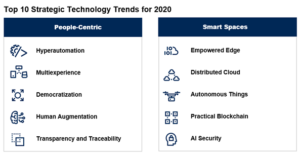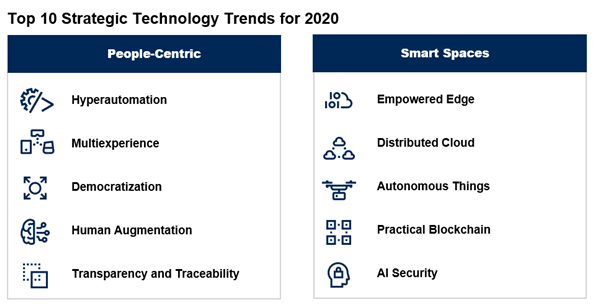Gartner defines a strategic technology trend as one with substantial disruptive potential that is beginning to break out of an emerging state into broader impact and use, or which is rapidly growing with a high degree of volatility reaching tipping points over the next five years.
“People-centric smart spaces are the structure used to organize and evaluate the primary impact of the Gartner top strategic technology trends for 2020,” said David Cearley, vice president and Gartner Fellow. “Putting people at the center of your technology strategy highlights one of the most important aspects of technology — how it impacts customers, employees, business partners, society or other key constituencies. Arguably all actions of the organization can be attributed to how it impacts these individuals and groups either directly or indirectly. This is a people-centric approach.”
“Smart spaces build on the people-centric notion. A smart space is a physical environment in which people and technology-enabled systems interact in increasingly open, connected, coordinated and intelligent ecosystems. Multiple elements — including people, processes, services and things — come together in a smart space to create a more immersive, interactive and automated experience,” said Mr. Cearley.
The top 10 strategic technology trends for 2020 are:

Hyperautomation
Hyperautomation is the combination of multiple machine learning (ML), packaged software and automation tools to deliver work. Hyperautomation refers not only to the breadth of the pallet of tools, but also to all the steps of automation itself (discover, analyze, design, automate, measure, monitor and reassess). Understanding the range of automation mechanisms, how they relate to one another and how they can be combined and coordinated is a major focus for hyperautomation.
This trend was kicked off with robotic process automation (RPA). However, RPA alone is not hyperautomation. Hyperautomation requires a combination of tools to help support replicating pieces of where the human is involved in a task.
Multiexperience
Through 2028, the user experience will undergo a significant shift in how users perceive the digital world and how they interact with it. Conversational platforms are changing the way in which people interact with the digital world. Virtual reality (VR), augmented reality (AR) and mixed reality (MR) are changing the way in which people perceive the digital world. This combined shift in both perception and interaction models leads to the future multisensory and multimodal experience.
“The model will shift from one of technology-literate people to one of people-literate technology. The burden of translating intent will move from the user to the computer,” said Brian Burke, research vice president at Gartner. . “This ability to communicate with users across many human senses will provide a richer environment for delivering nuanced information.”
Democratization of Expertise
Democratization is focused on providing people with access to technical expertise (for example, ML, application development) or business domain expertise (for example, sales process, economic analysis) via a radically simplified experience and without requiring extensive and costly training. “Citizen access” (for example, citizen data scientists, citizen integrators), as well as the evolution of citizen development and no-code models, are examples of democratization.
Through 2023, Gartner expects four key aspects of the democratization trend to accelerate, including democratization of data and analytics (tools targeting data scientists expanding to target the professional developer community), democratization of development (AI tools to leverage in custom-developed applications), democratization of design (expanding on the low-code, no-code phenomena with automation of additional application development functions to empower the citizen-developer) and democratization of knowledge (non-IT professionals gaining access to tools and expert systems that empower them to exploit and apply specialized skills beyond their own expertise and training).
Human Augmentation
Human augmentation explores how technology can be used to deliver cognitive and physical improvements as an integral part of the human experience. Physical augmentation enhances humans by changing their inherent physical capabilities by implanting or hosting a technology element on their bodies, such as a wearable device. Cognitive augmentation can occur through accessing information and exploiting applications on traditional computer systems and the emerging multiexperience interface in smart spaces. Over the next 10 years increasing levels of physical and cognitive human augmentation will become prevalent as individuals seek personal enhancements. This will create a new “consumerization” effect where employees seek to exploit their personal enhancements — and even extend them — to improve their office environment.
Transparency and Traceability
Consumers are increasingly aware that their personal information is valuable and are demanding control. Organizations recognize the increasing risk of securing and managing personal data, and governments are implementing strict legislation to ensure they do. Transparency and traceability are critical elements to support these digital ethics and privacy needs.
Transparency and traceability refer to a range of attitudes, actions and supporting technologies and practices designed to address regulatory requirements, preserve an ethical approach to use of artificial intelligence (AI) and other advanced technologies, and repair the growing lack of trust in companies. As organizations build out transparency and trust practices, they must focus on three areas: (1) AI and ML; (2) personal data privacy, ownership and control; and (3) ethically aligned design.
The Empowered Edge
Edge computing is a computing topology in which information processing and content collection and delivery are placed closer to the sources, repositories and consumers of this information. It tries to keep the traffic and processing local to reduce latency, exploit the capabilities of the edge and enable greater autonomy at the edge.
“Much of the current focus on edge computing comes from the need for IoT systems to deliver disconnected or distributed capabilities into the embedded IoT world for specific industries such as manufacturing or retail,” said Mr. Burke. “However, edge computing will become a dominant factor across virtually all industries and use cases as the edge is empowered with increasingly more sophisticated and specialized compute resources and more data storage. Complex edge devices, including robots, drones, autonomous vehicles and operational systems will accelerate this shift.”
Distributed Cloud
A distributed cloud is the distribution of public cloud services to different locations while the originating public cloud provider assumes responsibility for the operation, governance, updates to and evolution of the services. This represents a significant shift from the centralized model of most public cloud services and will lead to a new era in cloud computing.
Autonomous Things
Autonomous things are physical devices that use AI to automate functions previously performed by humans. The most recognizable forms of autonomous things are robots, drones, autonomous vehicles/ships and appliances. Their automation goes beyond the automation provided by rigid programing models, and they exploit AI to deliver advanced behaviors that interact more naturally with their surroundings and with people. As the technology capability improves, regulation permits and social acceptance grows, autonomous things will increasingly be deployed in uncontrolled public spaces.
“As autonomous things proliferate, we expect a shift from stand-alone intelligent things to a swarm of collaborative intelligent things where multiple devices will work together, either independently of people or with human input,” said Mr. Burke. “For example, heterogeneous robots can operate in a coordinated assembly process. In the delivery market, the most effective solution may be to use an autonomous vehicle to move packages to the target area. Robots and drones aboard the vehicle could then affect final delivery of the package.”
Practical Blockchain
Blockchain has the potential to reshape industries by enabling trust, providing transparency and enabling value exchange across business ecosystems, potentially lowering costs, reducing transaction settlement times and improving cash flow. Assets can be traced to their origin, significantly reducing the opportunities for substitutions with counterfeit goods. Asset tracking also has value in other areas, such as tracing food across a supply chain to more easily identify the origin of contamination or track individual parts to assist in product recalls. Another area in which blockchain has potential is identity management. Smart contracts can be programmed into the blockchain where events can trigger actions; for example, payment is released when goods are received.
“Blockchain remains immature for enterprise deployments due to a range of technical issues including poor scalability and interoperability. Despite these challenges, the significant potential for disruption and revenue generation means organizations should begin evaluating blockchain, even if they don’t anticipate aggressive adoption of the technologies in the near term,” said Mr. Burke.
AI Security
AI and ML will continue to be applied to augment human decision making across a broad set of use cases. While this creates great opportunities to enable hyperautomation and leverage autonomous things to deliver business transformation, it creates significant new challenges for the security team and risk leaders with a massive increase in potential points of attack with IoT, cloud computing, microservices and highly connected systems in smart spaces. Security and risk leaders should focus on three key areas — protecting AI-powered systems, leveraging AI to enhance security defense, and anticipating nefarious use of AI by attackers.
Gartner clients can read more in the Gartner Special Report “Top 10 Strategic Technology Trends for 2020.”
การ์ทเนอร์ระบุถึงแนวโน้มเทคโนโลยีที่สำคัญซึ่งจะก่อให้เกิดความเปลี่ยนแปลงครั้งใหญ่ในอนาคต โดยตอนนี้ยังอยู่ในระยะเริ่มต้นและคาดว่าจะได้รับการใช้งานอย่างแพร่หลายและสร้างแรงกระเพื่อมในวงกว้างมากขึ้น หรือมีแนวโน้มที่จะเติบโตอย่างรวดเร็วจนถึงระดับสูงสุดในช่วงอีก 5 ปีข้างหน้า
มร. เดวิด เซียร์ลีย์ รองประธานและผู้เชี่ยวชาญอาวุโสของการ์ทเนอร์ กล่าวว่า “People-Centric Smart Space คือโครงสร้างที่ใช้ในการจัดการและประเมินผลกระทบหลักของเทรนด์เทคโนโลยีที่สำคัญที่สุดที่การ์ทเนอร์ใช้ สำหรับปี 2563 การกำหนดกลยุทธ์ด้านเทคโนโลยีโดยยึดเอาผู้ใช้เป็นศูนย์กลางนับเป็นหนึ่งในแง่มุมที่สำคัญที่สุดของเทคโนโลยี โดยพิจารณาถึงผลกระทบของเทคโนโลยีที่มีต่อลูกค้า พนักงาน คู่ค้า สังคม และภาคส่วนอื่น ๆ ที่เกี่ยวข้อง การดำเนินการทั้งหมดขององค์กรจะต้องคำนึงถึงผลกระทบโดยตรงและโดยอ้อมที่จะเกิดขึ้นต่อบุคคลและกลุ่มต่าง ๆ และนี่คือแนวทางการดำเนินงานที่ให้ความสำคัญกับบุคคลเป็นหลัก”
“สมาร์ทสเปซสร้างขึ้นจากแนวคิดที่ให้ความสำคัญกับคน สมาร์ทสเปซเป็นสภาพแวดล้อมทางกายภาพที่ผู้คนและระบบที่อาศัยเทคโนโลยีมีปฏิสัมพันธ์กันในระบบนิเวศน์อัจฉริยะที่เปิดกว้าง มีการเชื่อมต่อถึงกัน และมีการประสานงานร่วมกันมากขึ้น หลาย ๆ องค์ประกอบ รวมถึงบุคคล กระบวนการ บริการ และอุปกรณ์ต่าง ๆ ทำงานร่วมกันในสมาร์ทสเปซ เพื่อสร้างสรรค์ประสบการณ์โต้ตอบแบบอินเทอร์แอคทีฟและกลมกลืนอย่างอัตโนมัติยิ่งขึ้น” มร. เซียร์ลีย์ กล่าวเพิ่มเติม
10 แนวโน้มเทคโนโลยีที่สำคัญที่สุดสำหรับปี 2563 มีดังนี้:

Hyperautomation
Hyperautomation เป็นการผสานรวมเทคโนโลยี Machine Learning (ML), ซอฟต์แวร์สำเร็จรูป และเครื่องมือต่าง ๆ สำหรับระบบงานอัตโนมัติเข้าไว้ด้วยกันเพื่อรองรับการทำงาน ไฮเปอร์ออโตเมชั่นนอกจากจะครอบคลุมเครื่องมือที่หลากหลายแล้ว ยังครอบคลุมทุกขั้นตอนของระบบงานอัตโนมัติ (ค้นหา วิเคราะห์ ออกแบบ ดำเนินการโดยอัตโนมัติ ตรวจวัด กำกับดูแล และประเมินผล) การทำความเข้าใจเกี่ยวกับกลไกที่หลากหลายของระบบอัตโนมัติ รวมถึงความเกี่ยวข้องกันของกลไกเหล่านี้ และแนวทางการผสานรวมกลไกต่าง ๆ เพื่อให้ทำงานร่วมกันได้อย่างกลมกลืนถือเป็นหัวใจสำคัญของไฮเปอร์ออโตเมชั่น
เทรนด์ดังกล่าวเริ่มต้นจากกระบวนการทำงานแบบอัตโนมัติ (Robotic Process Automation – RPA) อย่างไรก็ตาม ลำพังเพียงแค่ RPA ไม่ถือว่าเป็นไฮเปอร์ออโตเมชั่น เพราะระบบไฮเปอร์ออโตเมชั่นจำเป็นต้องอาศัยการผสานรวมเครื่องมือต่าง ๆ เพื่อทำหน้าที่แทนมนุษย์
Multiexperience
จนถึงปี 2571 ประสบการณ์การใช้งานของผู้ใช้จะมีการเปลี่ยนแปลงครั้งใหญ่ในส่วนที่เกี่ยวกับวิธีที่ผู้ใช้รับรู้และสัมผัสกับโลกดิจิทัล รวมถึงวิธีการโต้ตอบและมีปฏิสัมพันธ์กับโลกดิจิทัล แพลตฟอร์มการสนทนา (Conversational Platforms) ก่อให้เกิดการเปลี่ยนแปลงสำหรับรูปแบบการโต้ตอบระหว่างผู้ใช้กับโลกดิจิทัล ขณะที่ Virtual reality (VR), Augmented Reality (AR) และ Mixed Reality (MR) ทำให้รูปแบบการรับรู้และสัมผัสกับโลกดิจิทัลเปลี่ยนแปลงไป การเปลี่ยนแปลงทั้งหมดนี้ทั้งในส่วนของรูปแบบการรับรู้และการมีปฏิสัมพันธ์จะนำไปสู่ประสบการณ์แบบพหุประสาทสัมผัส (Multisensory) ในหลากหลายรูปแบบ (Multimodal)
มร. ไบรอัน เบิร์ก รองประธานฝ่ายวิจัยของการ์ทเนอร์ กล่าวว่า “โมเดลดังกล่าวจะเปลี่ยนแปลงจากรูปแบบของผู้ใช้ที่เรียนรู้เกี่ยวกับเทคโนโลยีไปสู่รูปแบบของเทคโนโลยีที่เรียนรู้เกี่ยวกับผู้ใช้ หน้าที่ในการแปลความหมายจะเปลี่ยนย้ายจากผู้ใช้ไปสู่คอมพิวเตอร์ ความสามารถในการติดต่อสื่อสารกับผู้ใช้ผ่านประสาทรับรู้หลายๆ ด้านของมนุษย์จะก่อให้เกิดสภาพแวดล้อมที่มีความหลากหลายสำหรับการนำเสนอข้อมูลที่มีความแตกต่างกันในระดับที่ละเอียดลึกซึ้งมากขึ้น”
Democratization of Expertise
Democratization การเปิดโอกาสให้ผู้คนเข้าถึงความเชี่ยวชาญด้านเทคนิค (เช่น ML, การพัฒนาแอพพลิเคชั่น) หรือความเชี่ยวชาญด้านธุรกิจ (เช่น กระบวนการขาย การวิเคราะห์ทางเศรษฐศาสตร์) ผ่านประสบการณ์ที่เรียบง่ายกว่าเดิม และไม่จำเป็นต้องเข้ารับการฝึกอบรมที่ยาวนานและเสียค่าใช้จ่ายจำนวนมาก ตัวอย่างเช่น นักพัฒนาทั่วไปที่สามารถทำหน้าที่เป็นดาต้า ไซแอนทิส (Data Scientists) หรือผู้ติดตั้งระบบโดยไม่ต้องมีความเชี่ยวชาญเฉพาะด้าน หรือสามารถพัฒนาโปรแกรมหรือสร้างโมเดลข้อมูลโดยไม่ต้องเขียนโค้ด
จนถึงปี 2566 การ์ทเนอร์คาดว่า 4 ปัจจัยที่สำคัญที่เป็นตัวเร่งแนวโน้ม Democratization ให้เกิดขึ้น ได้แก่ Democratization ในด้านข้อมูลและการวิเคราะห์ (เครื่องมือที่ใช้สำหรับนักวิทยาศาสตร์ข้อมูลจะขยายไปสู่ชุมชนนักพัฒนาระดับมืออาชีพ), การพัฒนา (ใช้เครื่องมือ AI ในการพัฒนาแอพพลิเคชั่น), การออกแบบ (ขยายไปสู่กระบวนการที่ไม่ต้องมีการเขียนโค้ดหรือใช้โค้ดน้อยมาก โดยอาศัยฟังก์ชั่นการพัฒนาแอพพลิเคชั่นเพิ่มเติมที่ทำงานแบบอัตโนมัติ เพื่อเสริมศักยภาพให้แก่นักพัฒนาทั่วไป) และความรู้ (บุคลากรที่ไม่ได้อยู่ในสายงานไอทีสามารถใช้เครื่องมือและระบบความเชี่ยวชาญเพื่อปรับใช้ทักษะเฉพาะด้าน)
Human Augmentation
Human Augmentation เป็นการใช้เทคโนโลยีเพื่อปรับปรุงทางด้านการรับรู้และกายภาพ โดยเป็นส่วนสำคัญของประสบการณ์ของผู้ใช้ Augmentation ในด้านกายภาพจะช่วยปรับปรุงหรือเปลี่ยนแปลงขีดความสามารถของมนุษย์ ด้วยการปลูกถ่ายหรือติดตั้งส่วนประกอบทางด้านเทคโนโลยีไว้บนร่างกายของมนุษย์ เช่น อุปกรณ์สวมใส่ ส่วน Augmentation ในด้านการรับรู้จะอาศัยการเข้าถึงข้อมูลและการใช้แอพพลิเคชั่นบนระบบคอมพิวเตอร์ทั่วไป รวมถึงอินเทอร์เฟซแบบ Multiexperience ในสภาพแวดล้อมของสมาร์ทสเปซ ในช่วง 10 ปีข้างหน้า จะมีการยกระดับ Human Augmentation ทั้งด้านกายภาพและการรับรู้ โดยจะได้รับการใช้งานอย่างแพร่หลายเพื่อเสริมสร้างประสบการณ์ของผู้ใช้ และจะนำไปสู่กระแส “Consumerization” รูปแบบใหม่ ซึ่งพนักงานจะพยายามใช้เทคโนโลยีเพื่อเสริมสร้างและขยายขีดความสามารถและประสบการณ์ของตนเอง และปรับปรุงสภาพแวดล้อมการทำงานภายในสำนักงาน
Transparency and Traceability
ผู้บริโภคมีความตระหนักรู้เพิ่มมากขึ้นว่าข้อมูลส่วนตัวของตนมีมูลค่า และดังนั้นจึงต้องการที่จะควบคุมข้อมูลดังกล่าว องค์กรต่าง ๆ รับรู้ถึงความเสี่ยงที่เพิ่มมากขึ้นของการปกป้องและจัดการข้อมูลส่วนตัว ขณะที่รัฐบาลเริ่มบังคับใช้กฎหมายที่เข้มงวดเพื่อให้มีการคุ้มครองและจัดการข้อมูลดังกล่าวอย่างเหมาะสม ความโปร่งใส (Transparency) และการตรวจสอบย้อนกลับ (Traceability) ถือเป็นองค์ประกอบสำคัญที่จะช่วยสนับสนุนจริยธรรมทางดิจิทัล (Digital Ethics) และการปกป้องความเป็นส่วนตัว
ความโปร่งใสและการตรวจสอบย้อนกลับหมายรวมถึงแนวคิด การดำเนินการ เทคโนโลยีที่รองรับ และแนวทางปฏิบัติที่ได้รับการออกแบบเป็นพิเศษเพื่อรองรับกฎระเบียบที่เกี่ยวข้อง และสนับสนุนแนวทางที่ถูกต้องตามหลักจริยธรรมสำหรับการใช้เทคโนโลยีปัญญาประดิษฐ์ (Artificial Intelligence หรือ AI) และเทคโนโลยีขั้นสูงอื่น ๆ รวมทั้งแก้ไขปัญหาการขาดความน่าเชื่อถือของบริษัทต่าง ๆ องค์กรที่พยายามจะสร้างความโปร่งใสและความน่าเชื่อถือจำเป็นที่จะต้องมุ่งเน้น 3 ส่วนหลัก ๆ ได้แก่ (1) AI และ ML; (2) การเก็บรักษา การครอบครอง และการควบคุมข้อมูลส่วนตัว และ (3) การออกแบบที่สอดคล้องกันตามหลักจริยธรรม
การเพิ่มขีดความสามารถให้กับส่วนขอบของเครือข่าย (Empowered Edge)
เอดจ์คอมพิวติ้ง (Edge Computing) เป็นโครงสร้างเครือข่ายคอมพิวเตอร์ที่จัดวางการประมวลผลข้อมูลและการรวบรวมและนำเสนอคอนเทนต์ไว้ใกล้กับแหล่งที่มา คลังข้อมูล และผู้ใช้ข้อมูลดังกล่าว โดยพยายามที่จะทำให้แทรฟฟิกและการประมวลผลอยู่ในเครือข่ายโลคอล เพื่อลดความหน่วง ใช้ประโยชน์จากทรัพยากรที่ส่วนขอบของเครือข่าย และเพิ่มอำนาจในการควบคุมและตัดสินใจให้กับระบบที่อยู่ส่วนขอบของเครือข่าย
มร. เบิร์ก กล่าวว่า “ความสนใจเอดจ์คอมพิวติ้งในปัจจุบันส่วนใหญ่มาจากความจำเป็นของระบบ IoT ที่ต้องรองรับการทำงานในลักษณะกระจัดกระจายในโลกของ IoT ที่มีอยู่ในอุปกรณ์ต่าง ๆ สำหรับอุตสาหกรรมหนึ่ง ๆ เป็นการเฉพาะ เช่น อุตสาหกรรมการผลิตหรือค้าปลีก อย่างไรก็ตาม ในอนาคต เอดจ์คอมพิวติ้งจะเป็นปัจจัยสำคัญต่อทุกกลุ่มอุตสาหกรรมและทุกการใช้งาน เพราะส่วนที่อยู่รอบนอกของเครือข่ายถูกเสริมศักยภาพด้วยทรัพยากรประมวลผลที่ก้าวล้ำและรองรับการใช้งานเฉพาะด้านมากขึ้น รวมไปถึงอุปกรณ์จัดเก็บข้อมูลที่มากขึ้น อุปกรณ์ลูกข่ายที่ซับซ้อน เช่น หุ่นยนต์ โดรน ยานพาหนะไร้คนขับ และระบบปฏิบัติการ จะเร่งให้เกิดการเปลี่ยนแปลงรวดเร็วยิ่งขึ้น”
ระบบคลาวด์แบบกระจาย (Distributed Cloud)
ระบบคลาวด์แบบกระจายหมายถึงการกระจายตัวของบริการคลาวด์สาธารณะไปยังสถานที่ต่าง ๆ โดยที่ผู้ให้บริการต้นทางของคลาวด์สาธารณะมีหน้าที่ควบคุม กำกับดูแล ปรับปรุง และพัฒนาบริการดังกล่าว ซึ่งนับเป็นการเปลี่ยนแปลงครั้งสำคัญจากเดิมที่บริการคลาวด์สาธารณะส่วนใหญ่มีลักษณะรวมศูนย์ (Centralized) และการเปลี่ยนแปลงนี้จะนำไปสู่ศักราชใหม่ของคลาวด์คอมพิวติ้ง (Cloud Computing)
อุปกรณ์อัตโนมัติ (Autonomous Things)
อุปกรณ์อัตโนมัติหมายถึงอุปกรณ์ทางกายภาพที่ใช้ AI เพื่อทำงานต่างๆ โดยอัตโนมัติ โดยเข้ามาแทนที่มนุษย์ อุปกรณ์อัตโนมัติที่พบเห็นได้ทั่วไปก็คือ หุ่นยนต์ โดรน ยานพาหนะ/เรือไร้คนขับ และเครื่องมือต่าง ๆ ที่ทำงานได้เอง การทำงานแบบอัตโนมัติที่ว่านี้จะครอบคลุมขอบเขตมากกว่าการทำงานอัตโนมัติตามโมเดลที่ตั้งค่าไว้อย่างตายตัว กล่าวคือ อุปกรณ์เหล่านี้จะใช้ AI เพื่อทำงานขั้นสูง และโต้ตอบกับคนหรือสิ่งรอบข้างได้อย่างเป็นธรรมชาติมากขึ้น ขณะที่ความสามารถทางเทคโนโลยีได้รับการพัฒนาปรับปรุงอย่างต่อเนื่อง กฎระเบียบก็มีการเปิดกว้างและอนุญาตให้ใช้งานอุปกรณ์เหล่านี้มากขึ้น และสังคมให้การยอมรับเพิ่มมากขึ้น ซึ่งจะส่งผลให้อุปกรณ์อัตโนมัติถูกใช้งานมากขึ้นในพื้นที่สาธารณะที่ปราศจากการควบคุม
มร. เบิร์ก กล่าวว่า “ขณะที่อุปกรณ์อัตโนมัติได้รับการใช้งานอย่างแพร่หลายมากขึ้น เราคาดว่าจะมีการเปลี่ยนแปลงจากอุปกรณ์อัจฉริยะที่ทำงานตามลำพังไปสู่กลุ่มอุปกรณ์อัจฉริยะหลาย ๆ เครื่องที่ทำงานร่วมกัน โดยอาจแยกเป็นอิสระจากคนหรืออาจมีการป้อนคำสั่งโดยมนุษย์ ตัวอย่างเช่น แขนกลหลากหลายรูปแบบที่ทำงานอย่างสอดประสานกันในโรงงานประกอบชิ้นส่วน ในส่วนของธุรกิจขนส่ง โซลูชั่นที่มีประสิทธิภาพมากที่สุดก็คือการใช้อุปกรณ์อัตโนมัติเพื่อเคลื่อนย้ายพัสดุไปยังพื้นที่เป้าหมาย โดยหุ่นยนต์และโดรนที่เดินทางไปพร้อมกับยานพาหนะอาจจะทำหน้าที่จัดส่งพัสดุถึงมือผู้รับปลายทาง”
บล็อกเชนที่ใช้งานได้ในทางปฏิบัติ
เทคโนโลยีบล็อกเชน (Blockchain) มีศักยภาพที่จะพลิกโฉมอุตสาหกรรมต่าง ๆ โดยจะช่วยสร้างความน่าเชื่อถือ ความโปร่งใส และรองรับการแลกเปลี่ยนมูลค่าในระบบนิเวศน์ทางธุรกิจ ทั้งยังช่วยลดต้นทุนและค่าใช้จ่าย เพิ่มความรวดเร็วในการทำธุรกรรม และปรับปรุงกระแสเงินสด เทคโนโลยีดังกล่าวช่วยให้สามารถตรวจสอบแหล่งที่มาของสินทรัพย์ จึงลดโอกาสที่จะมีการสลับเปลี่ยนเป็นสินค้าปลอม นอกจากนี้ การตรวจสอบติดตามสินทรัพย์ยังมีประโยชน์ในด้านอื่น ๆ เช่น การตรวจสอบสินค้าประเภทอาหารในซัพพลายเชนเพื่อระบุแหล่งที่มาของการปนเปื้อน หรือการตรวจสอบชิ้นส่วนที่เฉพาะเจาะจงเพื่อเพิ่มความสะดวกในการเรียกคืนสินค้า การใช้งานบล็อกเชนในอีกรูปแบบหนึ่งที่มีความเป็นไปได้ก็คือ การจัดการตัวตนผู้ใช้ นอกจากนี้ยังสามารถตั้งค่าสัญญาแบบ Smart Contract ไว้ในบล็อกเชน เพื่อให้เหตุการณ์อย่างใดอย่างหนึ่งเป็นทริกเกอร์ให้เกิดการดำเนินการอื่นต่อไป เช่น ระบบจะปลดล็อคการชำระเงินหลังจากลูกค้าได้รับสินค้า
มร. เบิร์ก กล่าวว่า “บล็อกเชนยังขาดความพร้อมสำหรับการใช้งานในระดับองค์กร เนื่องจากยังมีปัญหาด้านเทคนิคมากมายหลายประการ เช่น ขาดเสถียรภาพ และไม่สามารถใช้งานร่วมกันได้อย่างเหมาะสม อย่างไรก็ดี ถึงแม้จะมีปัญหาท้าทายดังกล่าว แต่เทคโนโลยีนี้มีศักยภาพที่สูงมากสำหรับการพลิกโฉมอุตสาหกรรมและการสร้างรายได้ ดังนั้นองค์กรต่าง ๆ จึงควรเริ่มต้นพิจารณาและประเมินความเป็นไปได้ของบล็อกเชน แต่เราคาดว่ายังคงไม่มีการปรับใช้เทคโนโลยีนี้อย่างจริงจังและเป็นรูปธรรมในอนาคตอันใกล้”
ระบบรักษาความปลอดภัย AI
AI และ ML จะยังคงถูกใช้งานเพื่อยกระดับการตัดสินใจของมนุษย์ในการใช้งานที่หลากหลาย ซึ่งจะช่วยสร้างโอกาสในการรองรับระบบไฮเปอร์ออโตเมชั่น และการใช้ประโยชน์จากอุปกรณ์อัตโนมัติเพื่อปรับปรุงธุรกิจ แต่ในขณะเดียวกันก็ทำให้เกิดปัญหาท้าทายใหม่ ๆ สำหรับทีมงานฝ่ายไอทีที่ดูแลด้านความปลอดภัยและผู้บริหารที่ต้องจัดการดูแลความเสี่ยง เพราะจะทำให้มีช่องทางการโจมตีเพิ่มขึ้นอย่างมากจากการใช้งาน IoT, คลาวด์คอมพิวติ้ง, ไมโครเซอร์วิส และระบบที่มีการเชื่อมต่อกันอย่างกว้างขวางในสมาร์ทสเปซ ผู้บริหารฝ่ายรักษาความปลอดภัยและความเสี่ยงควรจะให้ความสำคัญกับ 3 เรื่องหลัก ๆ ได้แก่ การปกป้องระบบที่ขับเคลื่อนด้วย AI, การใช้ AI เพื่อปรับปรุงระบบรักษาความปลอดภัย และการคาดการณ์เกี่ยวกับการใช้งาน AI โดยคนร้ายที่ต้องการโจมตีเครือข่าย
ลูกค้าของการ์ทเนอร์สามารถอ่านข้อมูลเพิ่มเติมได้ในรายงานพิเศษของการ์ทเนอร์ “10 เทรนด์เทคโนโลยีที่สำคัญที่สุดสำหรับปี 2563”

